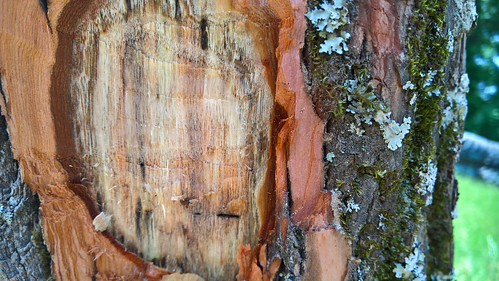Invasive disease, invasive beetle affect source of gumbo’s filé and root beer
By Mary Hightower
U of A System Division of Agriculture
Dec. 2, 2016
Fast Facts:
- Laurel wilt disease confirmed in Arkansas in late 2015
- Fungus is carried by non-native redbay ambrosia beetle
- Fact sheet on the disease available here: http://www.uaex.uada.edu/publications/pdf/FSA-5033.pdf
(280 words)
(Newsrooms: With image of fungus-stained sapwood at www.flickr.com/photos/uacescomm/31197483042 photo of young sassafras tree at www.flickr.com/photos/uacescomm/30535035134 and screenshot of fact sheet at www.flickr.com/photos/uacescomm/31197113372 )
LITTLE ROCK — An invasive beetle carrying an invasive disease is a threat to the tree whose leaves provide gumbo’s filé and whose below-ground parts provide the unique bite to root beer.
The disease can attack all members of the laurel family, and in Arkansas, that includes sassafras and redbay trees, as well as spicebush and pondberry shrubs.
“The laurel wilt fungus and its carrier, the redbay ambrosia beetle, were first discovered in Arkansas in late 2015,” said Tamara Walkingstick, associate director of the Arkansas Forest Resources Center and an extension forester for the University of Arkansas System Division of Agriculture.
Walkingstick said that as of August 2016, the disease was confirmed in two Arkansas counties --- Cleveland and Bradley, “and we’re expecting to see that number increase as forestry officials continue to search for both the disease and its beetle.”
The beetle was first identified near Savannah, Georgia, in 2002 and soon after, the disease was found in declining redbay trees.
Symptoms of laurel wilt include:
- Leaves drooping and turning red or purplish in the crown of the tree
- Sawdust “strings” protruding from the bark of the trees.
If those two symptoms are present, peel some bark from the tree. There may be small galleries cut into the sapwood by the beetles and the sapwood may have a dark stain, indicating fungal infection.
If you observe sassafras trees displaying crown wilt, please immediately contact your Cooperative Extension Service agent or your Arkansas Forestry Commission county forester and report your observation.
To learn more about the symptoms of laurel wilt, download the fact sheet “Laurel Wilt: An Invasive Pest of Sassafras in Arkansas,” at http://www.uaex.uada.edu/publications/pdf/FSA-5033.pdf
Contact your county extension office or visit www.uaex.uada.edu to learn more about landscape and forestry issues.
Pursuant to 7 CFR § 15.3, the University of Arkansas System Division of Agriculture offers all its Extension and Research programs and services (including employment) without regard to race, color, sex, national origin, religion, age, disability, marital or veteran status, genetic information, sexual preference, pregnancy or any other legally protected status, and is an equal opportunity institution.
# # #
Media Contact: Mary Hightower
Dir. of Communication Services
U of A Division of Agriculture
Cooperative Extension Service
(501) 671-2126
mhightower@uada.edu
Related Links
